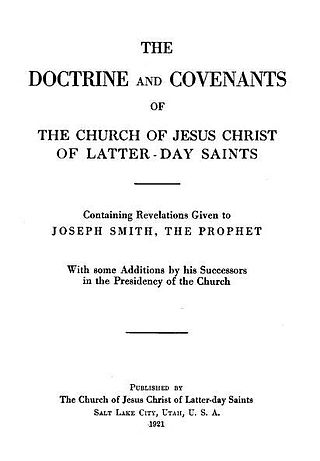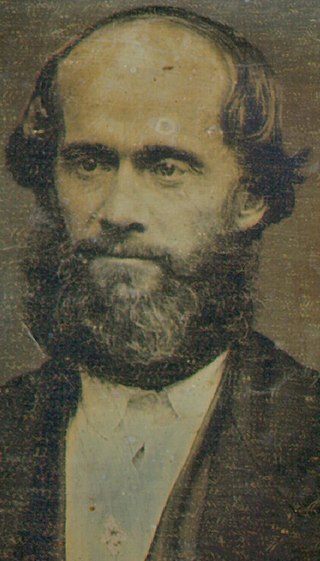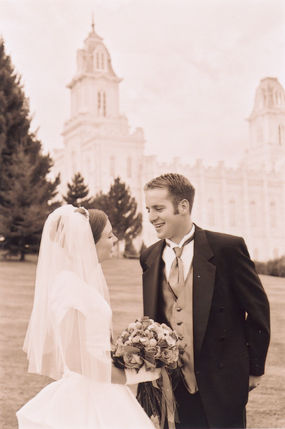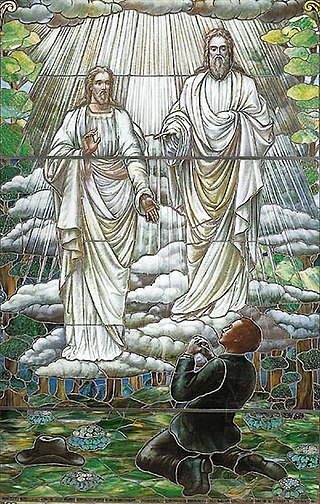
The Standard Works of the Church of Jesus Christ of Latter-day Saints are the four books that currently constitute its open scriptural canon. The four books of the standard works are:

The Doctrine and Covenants is a part of the open scriptural canon of several denominations of the Latter Day Saint movement. Originally published in 1835 as Doctrine and Covenants of the Church of the Latter Day Saints: Carefully Selected from the Revelations of God, editions of the book continue to be printed mainly by the Church of Jesus Christ of Latter-day Saints and the Community of Christ.

Mormonism is the religious tradition and theology of the Latter Day Saint movement of Restorationist Christianity started by Joseph Smith in Western New York in the 1820s and 1830s. As a label, Mormonism has been applied to various aspects of the Latter Day Saint movement, although there has been a recent push from the Church of Jesus Christ of Latter-day Saints to distance themselves from this label. A historian, Sydney E. Ahlstrom, wrote in 1982, "One cannot even be sure, whether [Mormonism] is a sect, a mystery cult, a new religion, a church, a people, a nation, or an American subculture; indeed, at different times and places it is all of these."
In Mormonism, the restoration refers to a return of the authentic priesthood power, spiritual gifts, ordinances, living prophets and revelation of the primitive Church of Christ after a long period of apostasy. While in some contexts the term may also refer to the early history of Mormonism, in other contexts the term is used in a way to include the time that has elapsed from the church's earliest beginnings until the present day. Especially in the Church of Jesus Christ of Latter-day Saints "the restoration" is often used also as a term to encompass the corpus of religious messages from its general leaders down to the present.

The Church of Jesus Christ of Latter Day Saints—usually distinguished with a parenthetical (Strangite)—is one of the several organizations that claim to be the legitimate continuation of the church founded by Joseph Smith on April 6, 1830. It is a separate organization from the considerably larger and better known Utah-based Church of Jesus Christ of Latter-day Saints (LDS Church). Both churches claim to be the original organization established by Smith. The Strangite church is headquartered in Voree, Wisconsin, just outside Burlington, and accepts the claims of James Strang as successor to Smith. It had approximately 300 members in 1998. Currently, there are around 130 active members throughout the United States.

The Latter Day Saint movement is the collection of independent church groups that trace their origins to a Christian Restorationist movement founded by Joseph Smith in the late 1820s.

The Latter Day Saint movement is a religious movement within Christianity that arose during the Second Great Awakening in the early 19th century and that led to the set of doctrines, practices, and cultures called Mormonism, and to the existence of numerous Latter Day Saint churches. Its history is characterized by intense controversy and persecution in reaction to some of the movement's doctrines and practices and their relationship to mainstream Christianity. The purpose of this article is to give an overview of the different groups, beliefs, and denominations that began with the influence of Joseph Smith.

Adam-ondi-Ahman is a historic site in Daviess County, Missouri, about five miles south of Jameson. It is located along the east bluffs above the Grand River. According to the teachings of The Church of Jesus Christ of Latter-day Saints, it is the site where Adam and Eve lived after being expelled from the Garden of Eden. It teaches that the place will be a gathering spot for a meeting of the priesthood leadership, including prophets of all ages and other righteous people, prior to the Second Coming of Jesus Christ.

Celestial marriage is a doctrine that marriage can last forever in heaven. This is a unique teaching of the Church of Jesus Christ of Latter-day Saints or Mormonism, and branches of Mormon fundamentalism.

Community of Christ and the Church of Jesus Christ of Latter-day Saints are two denominations that share a common heritage in the Church of Christ founded by Joseph Smith on April 6, 1830. Since Smith's death in 1844, they have evolved separately in belief and practices. The LDS Church is headquartered in Salt Lake City, Utah, and claims more than 16 million members worldwide; Community of Christ is headquartered in Independence, Missouri, and reports a worldwide membership of approximately 250,000.
The 1978 Revelation on Priesthood was a revelation announced by leaders of the Church of Jesus Christ of Latter-day Saints that reversed a long-standing policy excluding men of black African descent from the priesthood.

The Church of Jesus Christ of Latter-day Saints focuses its doctrine and teaching on Jesus Christ; that he was the Son of God, born of Mary, lived a perfect life, performed miracles, bled from every pore in the Garden of Gethsemane, died on the cross, rose on the third day, appeared again to his disciples, and now resides, authoritatively, on the right hand side of God. In brief, some beliefs are in common with Catholics, Orthodox and Protestant traditions. However, teachings of the LDS Church differ significantly in other ways and encompass a broad set of doctrines, so that the above-mentioned denominations usually place the LDS Church outside the bounds of orthodox Christian teaching as summarized in the Nicene Creed.
Islam and Mormonism have been compared to one another since the earliest origins of the latter in the nineteenth century, sometimes by detractors of one or both religions, but also at least once by Joseph Smith, founder of the Latter Day Saint movement, himself. Smith was also frequently referred to as "the Modern Muhammad" by several publications of the era, notably in the New York Herald, shortly after his asassination in June 1844. This epithet repeated a comparison that had been made from Smith's earliest career, one that was not intended at the time to be complimentary.
From 1852 to 1978, temple and priesthood policies in the Church of Jesus Christ of Latter-day Saints prohibited women and men of Black African descent from temple ordinances and ordination in the all-male priesthood. In 1978, the church's highest governing body, the First Presidency, declared in the statement "Official Declaration 2" that the restriction had been lifted. Between 1830 and 1852, a few black men had been ordained to the Mormon priesthood in the Latter Day Saint movement under Joseph Smith.

The President of the Church is the highest office of the Church of Jesus Christ of Latter-day Saints. It was the office held by Joseph Smith, the church's founder. The church's president is its leader and the head of the First Presidency, its highest governing body. Latter-day Saints consider the president of the church to be a "prophet, seer, and revelator" and refer to him as "the Prophet", a title that was originally given to Smith. When the name of the president is used by adherents, it is usually prefaced by the title "President". Russell M. Nelson has been the president since January 14, 2018.

The following outline is provided as an overview of and a topical guide to the Church of Jesus Christ of Latter-day Saints.
Exaltation is a belief in Mormonism that after death some people will reach the highest level of salvation in the celestial kingdom and eternally live in God's presence, continue as families, become gods, create worlds, and make spirit children over whom they will govern. In the largest Mormon denomination, the Church of Jesus Christ of Latter-day Saints, top leaders have taught God wants exaltation for all humankind and that humans are "gods in embryo". A verse in the LDS Church's canonized scripture states that those who are exalted will become gods, and a 1925 statement from the church's highest governing body said that "All men and women are in the similitude of the universal Father and Mother ... [and are] capable, by experience through ages and aeons, of evolving into a God."

Remnant fellowships are a loosely organized branch of the Latter Day Saint movement formed by individuals who accept alleged divine revelations received by Denver Snuffer Jr.. The Remnant Fellowships generally feel called to personal and social renewal preparatory to Christ's eventual second coming. According to movement beliefs, participants anticipate a coming time when remnants remain within the full restored covenant with Jesus Christ: an allusion to a belief that "The Bible, Book of Mormon, and modern revelation through the Prophet Joseph Smith, prophesy that the gospel of Jesus Christ would shift from the Gentile stewards of the gospel back to Israel in the last days." The movement places a renewed focus on individual communion with God, gifts of the spirit, tangible expressions of faith, and the eventual establishment of Zion. While the movement has no official name, the term "Snufferite" has been used to denote followers. Other designations include covenant of Christ movement and Denver Snuffer movement. Participants sometimes reference each other as "covenant Brother," "covenant Sister".












